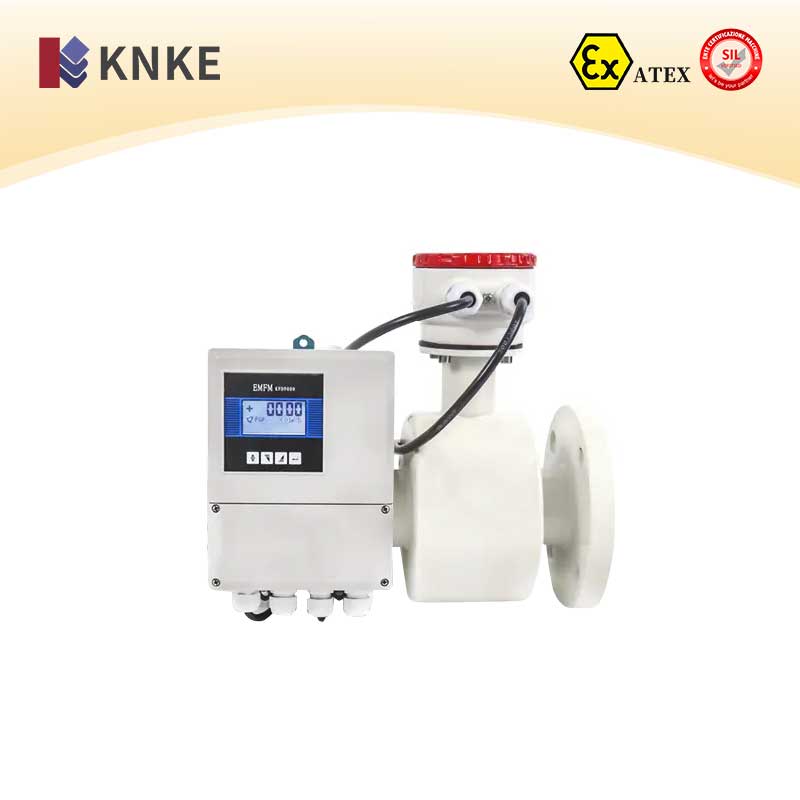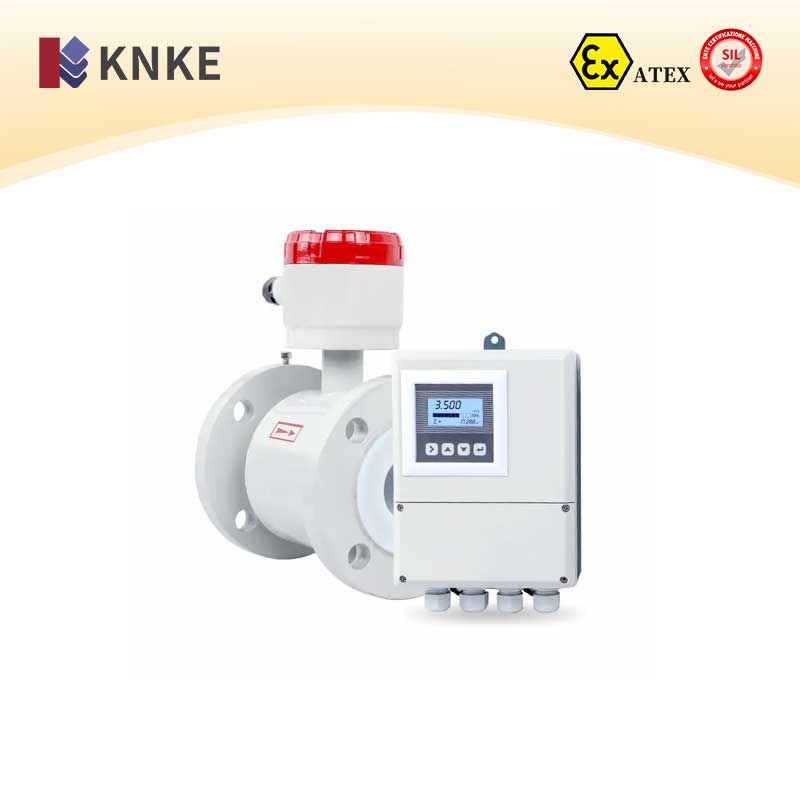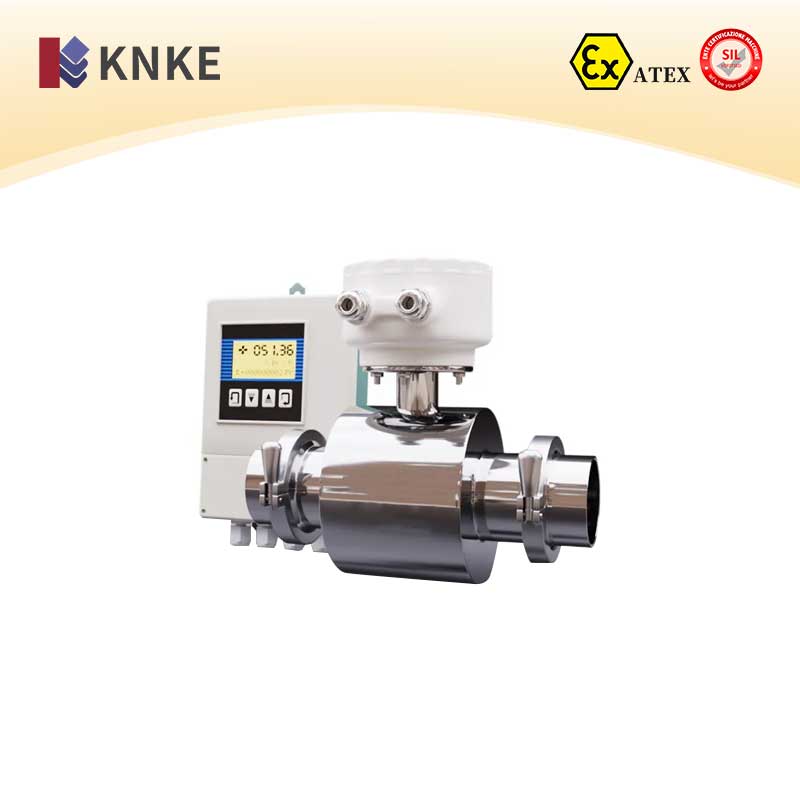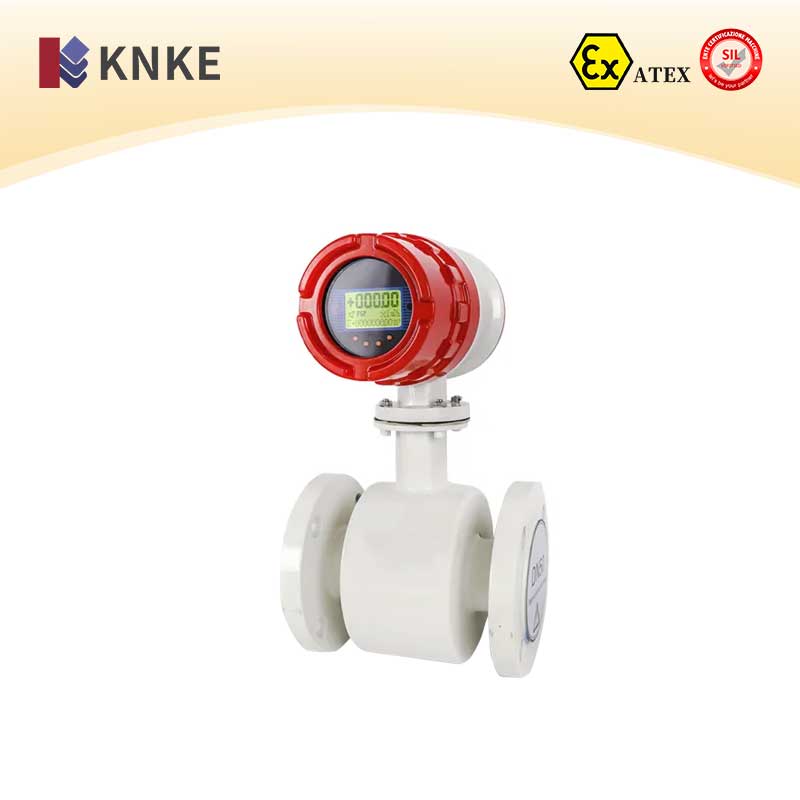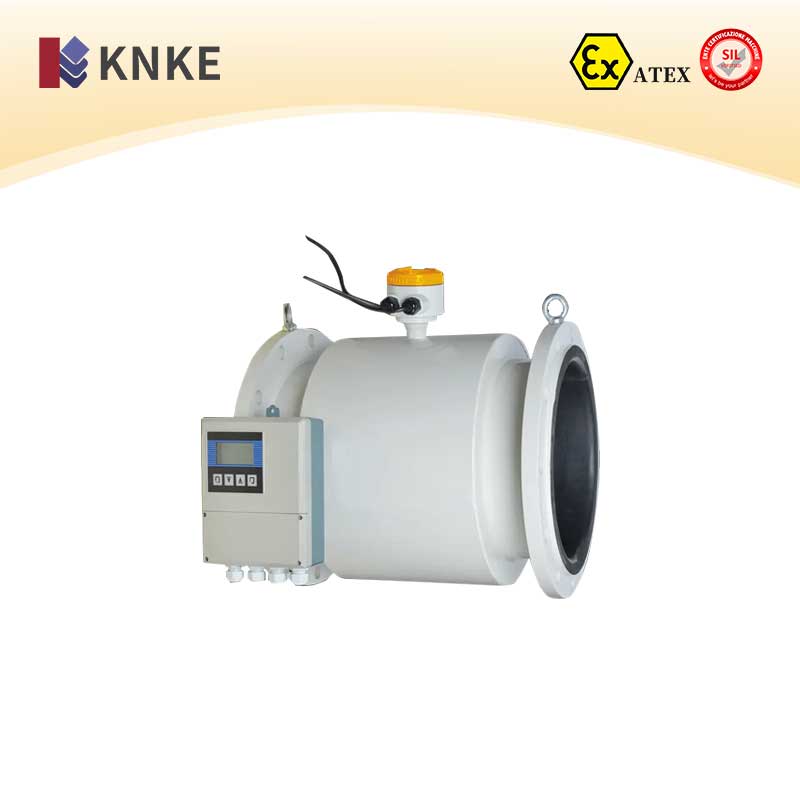Description
Overview of KNKE Split-Type Electromagnetic Flow Meter
The KNKE Split-Type Electromagnetic Flow Meter consists of two parts: a sensor and a transmitter. It operates based on Faraday’s Law of electromagnetic induction and is used to measure the volume flow rate of conductive liquids with an electrical conductivity greater than 5 µS/cm. This type of flow meter is suitable for measuring general conductive liquids, as well as strong corrosive liquids such as acids, alkalis, slurries, and other homogeneous liquid-solid suspensions.
It is widely used in industries such as petroleum, chemical, metallurgy, light industry, paper-making, environmental protection, food, and municipal water management for flow measurement in processes such as river dredging, water supply, and more.
Working Principle
The split-type electromagnetic flow meter uses Faraday’s Law of induction. Two detection electrodes are installed on the pipe wall, perpendicular to the magnetic field lines and the flow direction. As conductive liquid moves through the measuring tube, it cuts through magnetic lines of force, generating an induced potential. The value of this induced potential is directly proportional to the flow rate. The formula is:
E=K⋅B⋅V⋅DE = K \cdot B \cdot V \cdot D
Where:
- EE – Induced potential
- KK – A coefficient related to magnetic field distribution and axial length
- BB – Magnetic induction strength
- VV – Average flow velocity of the conductive liquid
- DD – Distance between electrodes (diameter of the measuring tube)
The sensor transmits the induced potential as a flow signal to the transmitter, which amplifies, filters, and processes the signal digitally to display instantaneous flow and accumulated flow on a backlit LCD screen. The transmitter also supports 4-20mA output, alarm output, frequency output, and communication interfaces such as RS-485, HART, and Modbus protocols.
Key Features
- Full Digital Processing: Strong resistance to interference, reliable measurement, high precision, and a flow range up to 150:1.
- Low EMI Power Supply: Excellent anti-EMI performance and stable operation under varying power supply voltages.
- 16-bit Embedded Microprocessor: Fast computation and high precision. Low-frequency excitation improves flow measurement stability and reduces power consumption.
- SMD and SMT Technology: High circuit reliability.
- No Moving Parts: No obstructive components in the pipeline, minimizing pressure loss during measurement.
- On-site Range Adjustment: Adjustable range as per user needs.
- Independent of Physical Parameters: Measurement results are unaffected by flow velocity distribution, fluid pressure, temperature, density, or viscosity.
- Backlit LCD Display: Clear readability with full Chinese menu operation, user-friendly and easy to operate.
- Communication Outputs: RS485, RS232, HART, Modbus, and other digital communication signals (optional).
- Self-Diagnosis and Self-Test: Built-in self-diagnosis functionality for easy maintenance.
- Hourly Totalizer: Accumulating flow totalizer by the hour for time-based metering (optional).
- Three Accumulators: Displays forward, reverse, and net accumulated flow values. Equipped with an internal clock that records power-down times (optional).
- Infrared Remote Control: 115kHz communication for non-contact operation at a distance (optional).
Performance Parameters
- Nominal Diameter: DN10 to DN600 for pipe-type PTFE lining, DN40 to DN2200 for pipe-type rubber lining (customizable).
- Flow Direction: Forward, reverse, and net flow measurement.
- Range Ratio: 150:1
- Repeatability Error: ±0.1%
- Accuracy: Pipe type: 0.5 grade, 1.0 grade
- Measuring Medium Temperature:
- Ordinary Rubber Lining: -20°C to +60°C
- High-Temperature Rubber Lining: -20°C to +90°C
- PTFE Lining: -30°C to +100°C
- High-Temperature PTFE Lining: -20°C to +180°C
- Rated Pressure:
- DN10 to DN150: ≤1.6MPa
- DN200 to DN350: ≤1.0MPa
- DN400 to DN1000: ≤0.6MPa
- DN450 to DN2200: ≤0.25MPa
- Flow Velocity Range: 0.1 to 15 m/s
- Conductivity Range: Fluid conductivity ≥ 5 μS/cm
- Signal Output: 4-20mA (load resistance 0-750Ω), pulse/frequency, control level
- Communication Output: RS485, Modbus, HART protocols
- Power Supply: AC220V or DC24V
- Straight Pipe Length Requirement: Upstream ≥ 5DN, downstream ≥ 2DN
- Connection Type: Flanged connections with national standard flange (GB/T9115.1-2000)
- Explosion-Proof Rating: ExdeiallBT4-T6
- Protection Rating: IP65 (customizable to IP68)
- Ambient Temperature: -25°C to +60°C
- Relative Humidity: 5% to 95%
- Total Power Consumption: Less than 20W
Liner Materials
- Rubber (Chloroprene): Moderate wear resistance, resistant to low-concentration acids, alkalis, and salts.
- Temperature: <60°C
- Applicable Liquids: Tap water, industrial water, seawater
- Polyurethane Rubber (PU): Excellent wear resistance but poor acid-alkali resistance.
- Temperature: <60°C
- Applicable Liquids: Paper pulp, mining slurry, etc.
- PTFE (F4): Excellent chemical stability, resistant to boiling hydrochloric acid, sulfuric acid, and strong alkalis.
- Temperature: <160°C
- Applicable Liquids: Highly corrosive acids, alkalis, and salts.
- FEP (F46): Chemically similar to PTFE, with superior compressive and tensile strength.
- Temperature: <120°C
- Applicable Liquids: Corrosive acid, alkali, and salt solutions.
Material Selection for Electromagnetic Flow Meter
- 316L Stainless Steel: Suitable for general industrial water, weakly corrosive acids, alkalis, and salts.
- Hastelloy B: Suitable for hydrochloric acid and sodium hydroxide solutions.
- Hastelloy C: Suitable for mixed acids and chromium acid, as well as seawater.
- Titanium (Ti): Suitable for chloride salts, sodium hydroxide, and ammonium salts.
- Tantalum (Ta): Suitable for sulfuric acid, hydrochloric acid, and nitric acid solutions.
- Platinum (Pt): Suitable for most acids, alkalis, and salt solutions.

